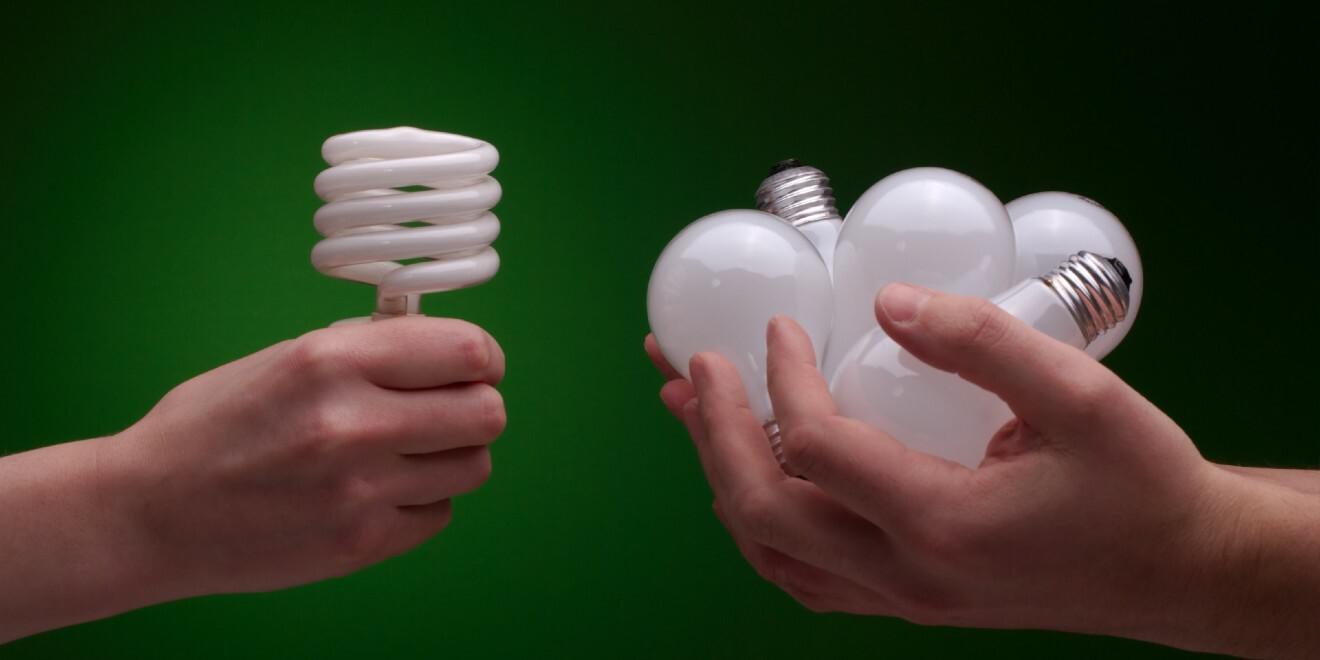The Four Types of Light Bulbs

Nothing sets the ambiance of a room like perfect lighting. Different types of light bulbs offer a variety of colors, bulb and base shapes, and energy efficiency options to suit your taste and priorities.
Whether you’re looking to replace a blown bulb or make an energy-conscious upgrade, understanding the difference between light bulbs is a smart place to start!
The Most Common Light Bulb Types
Walk into any US home, and you’ll likely find a mix of these four types of light bulbs hard at work. The clock is ticking on one bulb, however. While you may find a few hearty incandescent bulbs glowing brightly, it’s only a matter of time until the last one dims out for good.
-
Incandescent
For decades, the most common light bulb was the irrepressible incandescent bulb. The further production of traditional incandescent bulbs was banned on August 1, 2023, and for good reason: While inexpensive, incandescent lighting is much less efficient, using three times as much energy per lumen (a measure of light output) as an LED. One of the few lingering advantages of incandescent bulbs is that they are dimmable, which is key decision point for many households.
Incandescent Bulbs vs. LEDs
The decision to ban incandescent bulbs wasn’t taken lightly. Pushing homeowners toward LEDs is a win-win for consumers and the planet: LEDs are more energy-efficient, last longer, and emit more light than incandescent bulbs operating at the same wattage.
Related: Yes, There’s a Light Bulb Ban
Walking down the aisle at your local hardware store, you’ll find these three types of light bulbs that have replaced incandescent bulbs …
-
Light-emitting Diode (LED)
LED bulbs are one of the most energy-efficient light bulbs available. Unlike incandescent bulbs, LEDs emit no heat; unlike CFLs, they don’t contain the toxic chemical mercury. They also last an exceptionally long time. Most LED bulbs last 50,000 hours, or 2,083 days of non-stop use (not that you’d ever leave the lights on that long, of course).
LEDs emit a bright, sharp light ideal for task lighting, your home office, or your home gym. Combined with thick lampshades, they’re also a good fit for living rooms and bedrooms.
-
Compact Fluorescent (CFL)
CFLs take a moment or two to deliver full lighting levels, and while they do emit some heat, they’re substantially more energy-efficient than incandescent bulbs. CFLs are typically less expensive than LEDs and last nearly as long. They contain mercury, which makes them a good choice for outdoor lighting or illuminating basements, garages, and attics, to minimize exposure from when a CFL cracks or shatters. CFL bulbs are available in a range of colors and hues, depending on the model.
-
Halogen
Halogen light bulbs emit a brilliant white light and look similar to real sunlight! That makes them a great fit for recessed lighting fixtures and pendant lighting. Like incandescent bulbs, halogen bulbs are dimmable, which is perfect for households looking for flexible lighting solutions. However, halogens have a few shortcomings. They have the shortest lifespan of any bulb, and they burn extremely hot. Most manufacturers recommend using gloves when replacing a dead halogen bulb, even if you’ve allowed the bulb to cool off for a bit.
How to Choose the Right Light Bulb
When it’s time to replace a burned-out bulb, you want to choose a replacement that delivers the right light and operates efficiently.
Different light bulbs offer varying color temperatures and energy efficiency; here’s what to know …
Watts and Lumens
The brightness of light bulbs is measured in lumens, which is the perceived power of visible light. Plan on about 20 lumens per square foot of the room, and you should have a good idea of how many lumens you need and which type of bulb will be the most efficient.
Here’s a look at how each of the four light bulbs in use today stack up in terms of energy use:
|
Bulb |
Incandescent |
Halogen |
CFL |
LED |
|
450 lumens |
40 Watts |
29 Watts |
9 Watts |
6 Watts |
|
800 lumens |
60 Watts |
42 Watts |
14 Watts |
9 Watts |
Remember, you may have multiple fixtures, so you don’t need a single bulb to illuminate the entire space.
Correlated Color Temperature (CCT)
Correlated color temperature is used to gauge the color appearance of a light source. Measured in Kelvin (K) degrees, most bulbs have a CCT between 2,500K and 5,000K. A lower CCT is a softer, yellowish tone, while a higher CCT will be brilliant white. Restful, relaxing spaces typically benefit from bulbs rated at 3,500K or less.
Most LEDs, CFLs, and halogen bulbs are available in a range of lumens, watts, and CCT; your local Mister Sparky electrician will help you choose the perfect fit for your home during an indoor or outdoor lighting installation!
A Bright Idea: Call Mister Sparky!
Lighting allows families to derive more peace, joy, and comfort at home. From installing new lighting fixtures to making fast, affordable repairs, Mister Sparky Electric makes life a little easier.
You can count on our friendly, professional electricians to provide exceptional service with a smile – that’s just the way we’re wired! Find the location near you or call (800) 906-4577 today!
